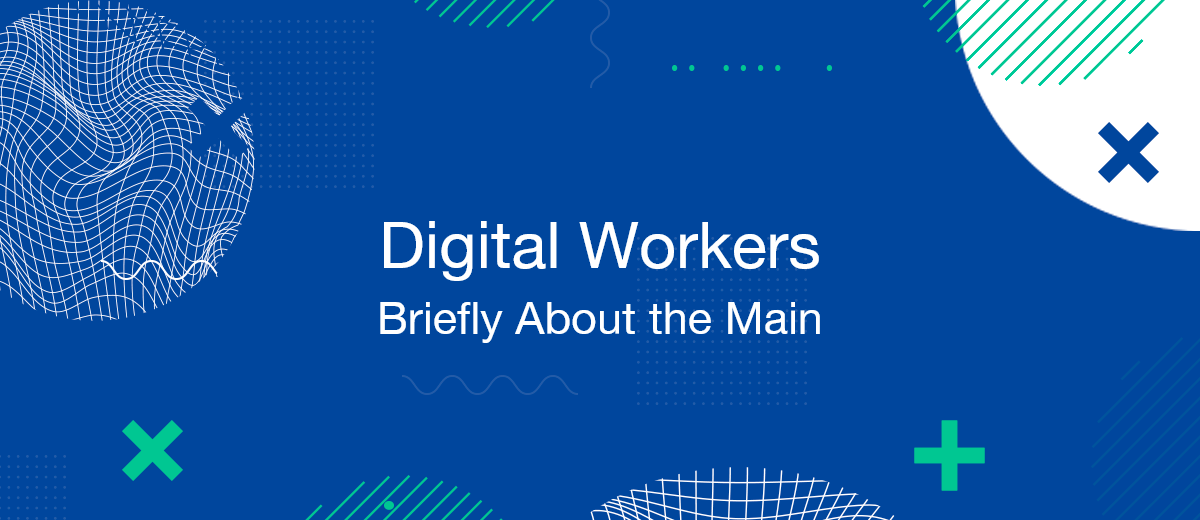Following generative neural networks and smart chatbots, another promising AI product has appeared on the market – digital workers. From our article you will learn what the new technology is, what its capabilities, advantages, problem areas and prospects are. In addition, we have prepared recommendations for you on the proper implementation of these systems.
What is a Digital Worker in Automation?
In the past, the term “digital worker” meant a person who had skills in working with a computer or some other modern electronics. Today, this is the name of a special category of software developed based on artificial intelligence technologies. It is capable of performing a range of complex end-to-end tasks on its own or with human workers. Such programs understand the intentions and carry out human commands, acting on their behalf. They can independently implement both entire processes and their significant stages, using the skills and data arrays acquired during training.

The functionality of digital employees is based on technologies of artificial intelligence, machine learning, robotic process automation and predictive analytics. These tools help automate work and thereby increase the efficiency of business processes. They act as assistants to human specialists, providing companies with many advantages in areas such as productivity growth, cost optimization and business scaling.
The Difference Between a Digital Worker and a Bot
After gaining an understanding of what a digital worker is, the next question usually arises. What is the main difference between an automated digital worker and a traditional automated bot? They are often considered the same tools, since both are business automation tools. However, in reality, this is not the case. There are several fundamental differences between them. A bot is a highly specialized product. It is designed to perform individual actions that are written in its program code. In fact, a simple bot does not need to use AI technology. Machine learning is sufficient for it to operate effectively.
In turn, digital workers can carry out more complex and end-to-end business functions from start to finish. In this way, they enhance and complement the capabilities of human workers. To achieve this, they are equipped with a wide range of technologies, which include AI, machine learning, robotic process automation (RPA) and analytics. Bots and digital workers have different levels of ability. The former automates one or at most many tasks at a time, while the latter simultaneously perform a set of actions, while analyzing the situation as a whole. In addition, they continually develop independently as they collect data and hone their skills.
Key Skills and Applications
Answering the question “What is a digital worker?” it's time to move on to the next important topic. Let's consider what opportunities such programs have and in what areas they are most in demand. Their key skills:
- Performing individual or complex actions in a complex process with or without human participation.
- Simultaneous work in multiple systems to improve decision-making efficiency.
- Communication with people, understanding their intentions and adjusting your actions in accordance with them. This includes the ability to ask and answer questions using natural language.
- Analysis of unstructured data with generation of conclusions and forecasts. Making decisions based on processed information.
All these and other abilities provide such systems with significant competitive advantages when comparing digital worker vs bot. They effectively help people in many business processes, including scheduling meetings, preparing documents and business proposals. They have also excelled in obtaining approvals, fraud detection, claims processing, and customer service operations.
The versatility of digital workers allows them to be used in different areas of activity. They have proven themselves well in the following areas:
- Sales and customer support. AI systems successfully communicate and interact with customers, answering questions about products and providing them with all possible assistance. They know how to competently sort requests, fulfilling high-priority requests first. Participation in these programs reduces the workload of sales and customer service managers, increasing their productivity.
- Supply chain management. Large retailers actively use robots controlled by digital workers to check the quantities, prices and other parameters of goods in warehouses. They can also help gather information about suppliers and their products, thereby helping purchase managers make better decisions.
- Personnel management. Virtual assistants, developed based on artificial intelligence, collect and process data about employees. They advise them in real time and transfer complex cases to HR managers.
Advantages and Challenges
We have just dealt with the digital worker definition and its characteristics. Now it's time to look at the main benefits of these digital tools, as well as the challenges that may arise when implementing them. Let's start with the advantages:
- Increased productivity and efficiency. Integrating digital workers has a positive impact on most key business metrics. Their values will steadily increase as you begin to increase the implementation of AI in various processes of your company.
- Minimizing errors and costs. Such systems significantly reduce the number of errors that occur when performing tasks due to the human factor. Therefore, enterprises use digital employees in areas where the cost of error is especially high. They also help reduce costs, accelerating your return on investment.
- Automation of routine. The ability of neural networks to automate repetitive processes brings enormous benefits to businesses. Thanks to them, companies can free their staff from everyday routine, taking them on more important and complex tasks.
Information about what a digital worker is would be incomplete without mentioning the associated business challenges. These include:
- Implementation costs. Deploying a digital worker can be expensive, both in terms of time and money. Various factors influence the budget and timing of a project. First, the goals and scope of integration. In addition, you should consider the cost of training staff to effectively use AI.
- Quality and volume of data. As is the case with other artificial intelligence systems, data is the most significant factor in the effectiveness of digital workers. Neural networks trained on incomplete or low-quality data will not only be useless, but can also harm your business. Therefore, before implementing them, special attention must be paid to data collection and analysis. Of course, this will require additional resources.
- Problems of adaptation and scaling. Integrating AI technologies into long-standing processes is considered another major challenge. You may need to fundamentally rethink and modernize them to successfully integrate digital workers. Not having enough tasks to automate can make their use uneconomical. Difficulties in adapting and customizing such systems will hinder their scaling.
Implementation Recommendations
Now that you have a general idea of what is the difference between a digital worker and a bot, it’s time to get acquainted with the brief instructions for implementing these AI systems. When starting a project, we recommend consistently following steps:
- Need assessment. The first step is to identify the area or process where the digital employee will be involved. Some companies do not integrate complex systems from scratch, but first introduce individual elements of AI to perform simple tasks (for example, data collection). After testing them, they connect additional software, expanding the capabilities of the platform.
- Documentation. Before starting a project, it is imperative to prepare documentation. It should describe the technology being implemented, its capabilities, responsibilities, and other operational aspects. Detailed documentation will help you train digital workers correctly and quickly.
- Education. Once the documentation is complete, move on to the key step—training your digital workforce. This procedure is carried out by engineers and data scientists. They train neural networks to perform work tasks within the framework of their assigned responsibilities. AI is also trained to interact with human colleagues by redirecting complex cases to them.
- Performance assessment. At the final stage of implementation, you can evaluate the contribution of digital workers to optimizing your company’s business processes. For these purposes, analysis, and process mapping are used to monitor the effectiveness of AI training and identify possible errors in its work.
Many entrepreneurs who want to integrate digital worker solutions are interested in how difficult it is to prepare such an AI tool and how long it will take. The complexity of implementing neural networks directly depends on your requirements and the level of software customization. Nowadays, solutions are available on the market with a set of built-in skills that can be expanded and adapted to specific business processes. The parameters and scale of the system also determine the speed of its integration. If deadlines are critical, look for ready-to-deploy platforms with minimal configuration to get results without delay.
Prospects for Technology Development
So, you have found out what a digital worker is and what capabilities it has. This means that it’s time to move on to the final part of the article – the forecast for the development of this tool in the near future. Constant improvement of artificial intelligence technologies opens up great prospects for such systems. Their ability to learn and interact with people will create a hybrid workforce. The impeccable professional skills of AI will be complemented by creativity, communication, and other human qualities important for business success.
According to experts, the further introduction of digital employees will create the preconditions for such transformations:
- Increased labor productivity. Artificial intelligence does not require breaks, weekends or vacations. It doesn't get sick or suffer from burnout. Most routine business processes can be delegated to AI in the near future. This will increase labor productivity and begin to bring more profit to companies.
- Professional growth of personnel. Freed from routine, people will have more time for professional development. AI-based automation will allow them to focus on more important and higher-paying tasks. It is important to understand that the introduction of digitalization does not deprive a person of work. It helps work more efficiently and grow faster.
- Development of soft skills. As digital workers spread into different areas of business, so-called soft skills will become much more in demand. Digitalization will make people's work more creative and interesting. Thanks to it, the demand for skills in creativity, communication, leadership, self-organization and emotional intelligence will increase.
Conclusion
The implementation of the digital worker ecosystem in business may become a massive trend in the near future. Such systems represent the next stage in the development of artificial intelligence after generative neural networks and AI chatbots. They are trained to perform complex actions, which allows them to solve complex end-to-end problems both individually and jointly with people. Digital employees can bring significant benefits to a business by automating routine processes, reducing errors, and optimizing costs. In the future, these AI tools will turn into full-fledged participants in the labor market and ensure the professional growth of human workers.
Would you like your employees to receive real-time data on new Facebook leads, and automatically send a welcome email or SMS to users who have responded to your social media ad? All this and more can be implemented using the SaveMyLeads system. Connect the necessary services to your Facebook advertising account and automate data transfer and routine work. Let your employees focus on what really matters, rather than wasting time manually transferring data or sending out template emails.
